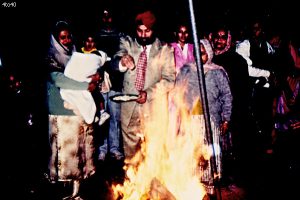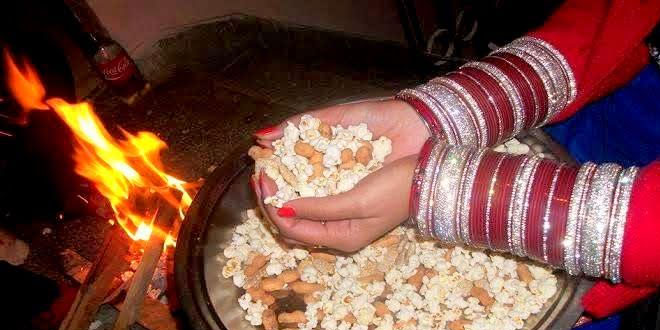First Lohri of Bride or The New Born: The first Lohri celebrated by a new bride or a newborn represents a grand occasion and immediate family members are invited for feast and exchange of gifts. Once the party is over, Lohri is celebrated with traditional dancing and singing around the bonfire. Lohri pampers women and children. This is particularly a happy occasion for the couples who for the first time celebrated Lohri after their marriage and also first Lohri of a new born child either a girl or a boy in a family.
 On the first Lohri of the the recently wedded bride or a new born, people give offerings of dry fruits, revri (a kind of sweet made of sugar and sesame seeds), roasted peanuts, Sesame Ladoo and other foods to the fire, as well as sharing them with their family and friends gathered around the fire. They perform the “Bhangra” dance, in groups around the fire. The dancing and singing continues well into the night. The Bhangra dance has rhythmic movements of the feet, shoulders and body, with outstretched hands and a lot of clapping by women partners. Food eaten is generally vegetarian and traditionally, no alcoholic drinks are supposed to be consumed.
On the first Lohri of the the recently wedded bride or a new born, people give offerings of dry fruits, revri (a kind of sweet made of sugar and sesame seeds), roasted peanuts, Sesame Ladoo and other foods to the fire, as well as sharing them with their family and friends gathered around the fire. They perform the “Bhangra” dance, in groups around the fire. The dancing and singing continues well into the night. The Bhangra dance has rhythmic movements of the feet, shoulders and body, with outstretched hands and a lot of clapping by women partners. Food eaten is generally vegetarian and traditionally, no alcoholic drinks are supposed to be consumed.
First Lohri of a bride:
The first Lohri of a bride is considered very important. It is celebrated with increased fervor and on a larger scale. The family of the newly wedded wife and husband gather around the fire wearing their best, often new clothes, decorated with beautiful Punjabi embroidery in gold and silk threads with mirror work. The newly married woman wear new bangles, apply henna or ‘mehndi’ on their hands and put a colorful bindi, a decorative spot, on their foreheads. The husband also wear new clothes and colorful turbans. The new bride of the family on her first Lohri, is presented with beautiful new clothes and jewelry by her parent in-laws. She wears bangles almost up to her elbows.
The first Lohri celebrated by a new bride represents a grand occasion and is comparable to the Sindhara of Rajasthan and Delhi. The mother-in-law presents heavy garments and jewelry to the new bride. Unlike Sindhara, in this case the bride remains in her in-law’s house where a grand feast is arranged and all sons and daughters of the house with their spouses and children and all their close friends and neighbors are invited. Early in the evening, when the main people have arrived, the new bride is dressed in her best salwar suit or ghaghra and is made to sit, along with her husband, in a central place where the father-in-law and mother-in-law perform the presentation of clothes and jewelry. The close relatives and friends also join in and present clothes or cash to the new bride.
First Lohri of a new born:
The first Lohri of a new born is a special occasion in which all friends and family join to celebrate. It is performed in the later part of the evening. Invitation cards can be sent for this function, depending on how one wants to celebrate. The event is observed at the parental home of the child in the presence of close relatives, friends and well-wishers. All the guest and relatives bring gifts for the baby and the new mother. The child’s maternal grandparents give gifts to the child’s paternal relatives also.
On the first Lohri of a new-born baby, the mother attired in heavy clothes and wearing a lot of jewelry with mehndi on her hands and feet sits with the baby in her lap. The family does the presentations. The mother-in-law and father-in-law of course give a large quantity of presents in the form of clothes and cash and others do so according to their relationship with the couple as also their capability and desire. The maternal grandparents also send gifts of clothes, sweets, rayveri, peanuts, popcorn and fruits.
Lohri is then celebrated with traditional dancing and singing around the bonfire. Logs of wood are piled together for a bonfire, and friends and relatives gather around it. They go around the fire three times, giving offerings of popcorns, peanuts, rayveri and sweets. Then, to the beat of the dhol (traditional Indian drum), people dance around the fire. Prasad of til, peanuts, rayveri, puffed rice, popcorn, gajak and sweets is distributed. This symbolizes a prayer to Agni for abundant crops and prosperity. An elaborate traditional Punjabi dinner is served, comprising shaahi paneer, ma ki daal, makki ki roti, sarson ka saag etc.
 Kids Portal For Parents India Kids Network
Kids Portal For Parents India Kids Network







